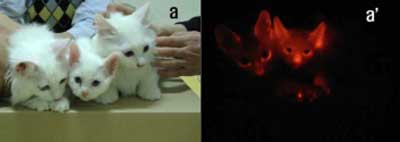Cloned Red Fluorescent Cat
In 2007 Professor Kong Il-keun, of the Gyeongsang National University, South Korea, announced he had cloned the world’s first red fluorescent cat. The South Korean researcher chose to create a genetically modified cloned cat because we know a lot about the genetics and reproductive systems of cats and they are better models of humans than mice.
Kong read about the techniques used to clone “Cc” (named for the abbreviation for carbon copy), the first feline clone, who was born Dec. 22, 2001, on the campus of Texas A&M. Cc’s creation was funded by Genetic Savings & Clone, a company created to clone the pets of wealthy cat owners. However, the company could not attract enough clients, it only managed to sell two cloned cats at between $32,000 and $50,000 each. It closed its doors in 2006.
After reading about Cc, Kong, a medical researcher, cloned his first cat in 2004. Kong is not interested in creating clones of pets, instead his interest is grounded in the fact that there is no genetic variability between clones, which makes them ideal subjects for the study of inherited diseases. These feline genetic diseases are of special interest to those in the medical community because approximately 250 of the diseases are also found in humans.
Three 60 day old kittens. Two have been genetically modified to make red fluorescent protein. All three look similar under normal light, but when irradiated with blue light only the two genetically modified kittens glow red. (Photo courtesy of Biology of Reproduction)
The kittens with the red fluorescent noses were created to prove a cloned cat could be genetically modified. To create his cloned kittens, Kong took skin cells from a female Turkish Angora cat and genetically modified these skin cells with a gene that encoded for a fluorescent protein found in corals. The nuclear material from the genetically modified skin cells was placed in the evacuated nucleus of a fertilized ovum, which was then implanted into the womb of the donor. The resultant kittens glow red when irradiated with blue light – proof that the clones had been genetically modified. One kitten was still-born, yet an autopsy showed that all its cells contained red fluorescent protein (RFP) and fluoresced.
While Kong’s kittens are the first glowing cloned cats, he is not the first to use fluorescent proteins as markers for genetic change in cloned mammals. Randy Prather, a professor of reproductive biotechnology at the University of Missouri, Columbia, is one of the researchers at the forefront of the creation of transgenic swine for medicine. Prather often uses fluorescent proteins as a marker to show that foreign genes can be expressed in transgenic swine.
